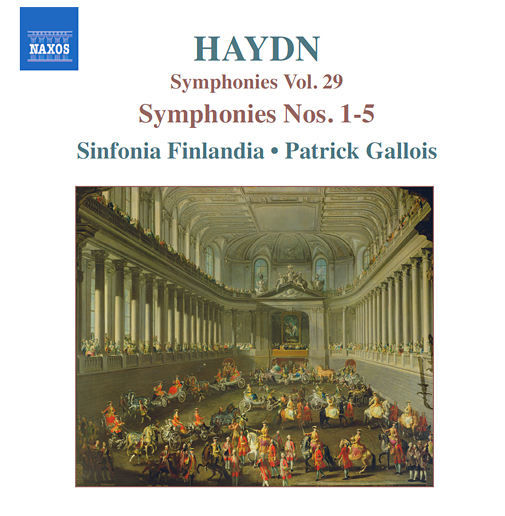I’m Listening to Everything Composed by Franz Joseph Haydn
July 15, 2013
TITLE: Symphony #1 in D Major
A common misconception about a piece of classical music with “#1” or “opus 1” attached to the title is that the work is an example of juvenilia. In the case of Mozart, that may be true, but in the case of most composers, labeling something with a “1” is not an indication that it is an immature work. In most cases, composers had composed many pieces prior to their “opus 1”, but simply didn’t number the earlier works because the composers were students at the time, not yet established in their career, or simply didn’t feel that the early works were good representations of what they hoped to achieve as a composer. So, when you see “opus 1” or “#1,” do not dismiss it as juvenilia. Instead, realize that it means that the composer felt that it WAS worthy of being counted as part of their overall oeuvre (say that ten times fast! “overall oeuvre – overall oeuvre – overall oeuvre”).
DESCRIPTION OF THE PIECE:
Haydn’s first full-time employment was when he was hired (at the age of 25) as Kapellmeister for Count Morzin. Prior to this, his reputation had been growing and he had been hired part time by a number of aristocrats. Haydn’s “Symphony #1” was composed when he was 27 years old and still in Count Morzin’s employment.
1st Movement: Presto
This appears to be in basic sonata form (A-B-A, or “Exposition-Development-Recapitulation”). I’ll try to walk you through it, step by step. It may prove helpful to you to open up the orchestral score for this piece, since I’m going to refer to specific measure numbers. You can find the score at http://javanese.imslp.info/files/imglnks/usimg/7/7a/IMSLP284168-PMLP71223-Haydn_SINFONIA_No_1_-_Full_Score_D.pdf
By the way, before you continue reading/listening, I’ve never felt very confident in my score analysis skills, so if you find any glaring mistakes, don’t hesitate to let me know in the comments section. I won’t be offended and it will help me learn more.
The EXPOSITION’s first theme begins with a technique known as the Mannheim Crescendo, essentially a crescendo effected by the entire orchestra. It is in the key of D Major. At measure 10, we’re still in D Major, but I think this is the start of the bridge which modulates at measure 14 to A Major. Somewhere around m. 17 or 18 I believe is the start of the 2nd theme, and then at measure 29, the cadence theme begins. The exposition ends at m. 39, but then there is a repeat sign, so we get the entire exposition again!
The DEVELOPMENT begins at m. 40 and features lots of modulations (i.e., try to hum the tonic, it doesn’t stick around for very long).
The RECAPITULATION begins at m. 59, but this time it doesn’t modulate during the bridge. Well, it does modulate ever so briefly, but only to artistically get us back to the tonic (D major).
At the end of the Recap, Haydn chose to use repeat signs so that we get to hear the entire Development AND Recap one more time!
2nd movement: Andante
I’m not 100% certain, but I think this is also in sonata form.
Exposition
1st theme
Bridge starts at pick-ups to m. 11
2nd theme at m. 15 (I think?)
Cadence theme at pick-ups to m. 21.
Development starts at pick-ups to m. 29. Fun little polyphonic back and forth exchanges between the first violins and second violins highlight the modulations.
Then at pick-up to m. 50, we have the Recap, but it is modified a bit. It replicates and expands upon the material found in the Exposition in mm. 6-14 before getting to the more recognizable bridge (earlier at m. 11, now at pick-up to m. 61).
And again, Haydn repeats the entire Development and Recap.
3rd movement: Finale: Presto
I’m fairly certain this is in a Rondo form in the following pattern
AABABA
I could be wrong… (I almost always get lost in rondo form…)
HIGHLIGHT: For me, this was mostly an exercise in simply noticing the characteristics of this time period. This isn’t a symphony that I will listen to over and over again—it didn’t move me deeply—it didn’t make me cry, or really feel anything other than “Oh, how charming!” And when it comes right down to it, that is to a great degree what the Classical Era of music was all about. The composers of the day really wanted audiences to react with “Oh, how charming!” Well, it is charming and it probably made Haydn’s patron, Count Morzin, happy that he had hired young Haydn. If I had to pick a highlight, I’d simply say that, at least in the recording I listened to (Sinfonia Finlandia, Naxos label, catalog #8.557571), the harpsichord player was having a grand time improvising chords to the bass line in the 2nd movement.
WHAT’S LEFT TO LISTEN TO BY HAYDN? A lot! Especially considering he wrote over 100 symphonies. It’s going to take me a while, but I’ll do it!
